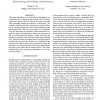Free Online Productivity Tools
i2Speak
i2Symbol
i2OCR
iTex2Img
iWeb2Print
iWeb2Shot
i2Type
iPdf2Split
iPdf2Merge
i2Bopomofo
i2Arabic
i2Style
i2Image
i2PDF
iLatex2Rtf
Sci2ools
ISBI
2006
IEEE
2006
IEEE
3D tumor shape reconstruction from 2D bioluminescence images
This paper introduces a novel and efficient algorithm for reconstructing the 3D shapes of tumors from a set of 2D bioluminescence images which are taken by the same camera but after continually rotating the animal by a small angle. The method is efficient and robust enough to be used for analyzing the repeated imaging of a same animal transplanted with gene marked cells. There are several steps in our algorithm. First, the silhouettes (or boundaries) of the animal and its interior hot spots (corresponding to tumors) are segmented in the set of bioluminescence images. Second, the images are registered according to the projection of the animal rotating axis. Third, the images are mapped onto 3D projection planes and from the viewpoint of each plane, the visual hulls of the animal and its interior tumors are reconstructed. Finally, the intersection of visual hulls from all viewpoints approximates the shape of the animal and its interior tumors. The experimental results show promising per...
| Added | 20 Nov 2009 |
| Updated | 20 Nov 2009 |
| Type | Conference |
| Year | 2006 |
| Where | ISBI |
| Authors | Junzhou Huang, Xiaolei Huang, Dimitris N. Metaxas, Debarata Banerjee |
Comments (0)

